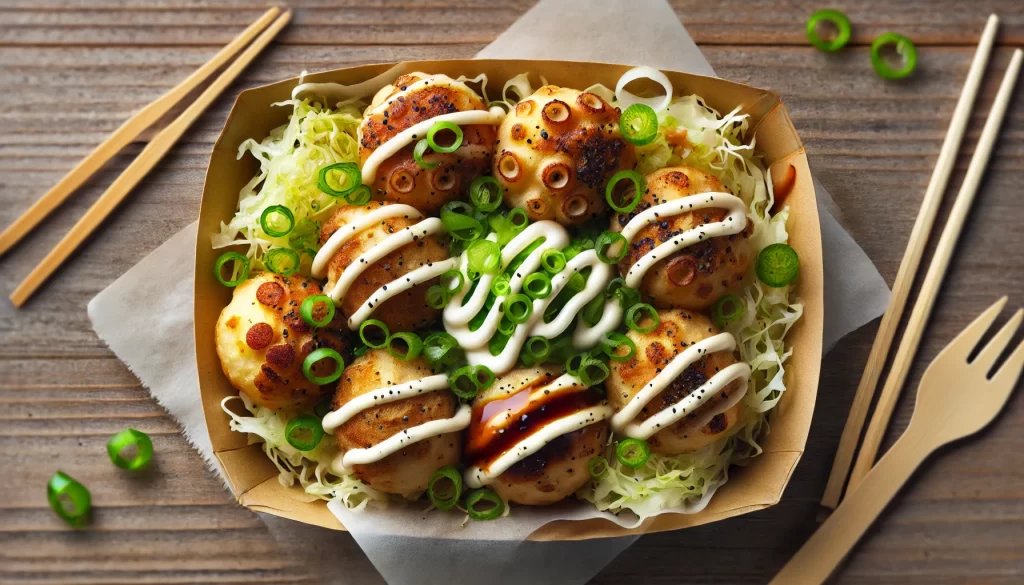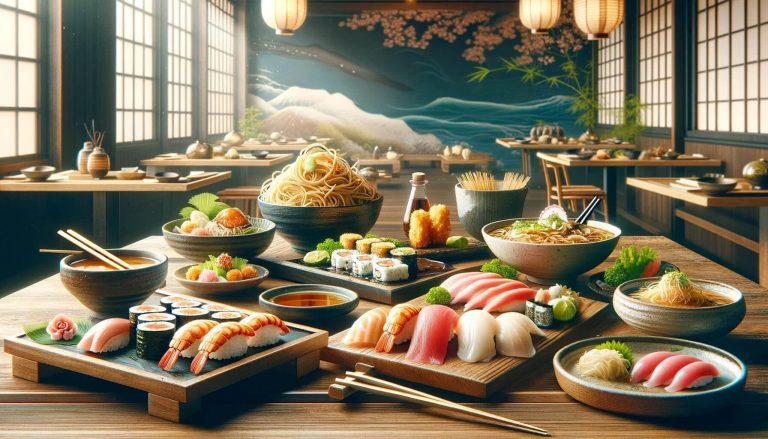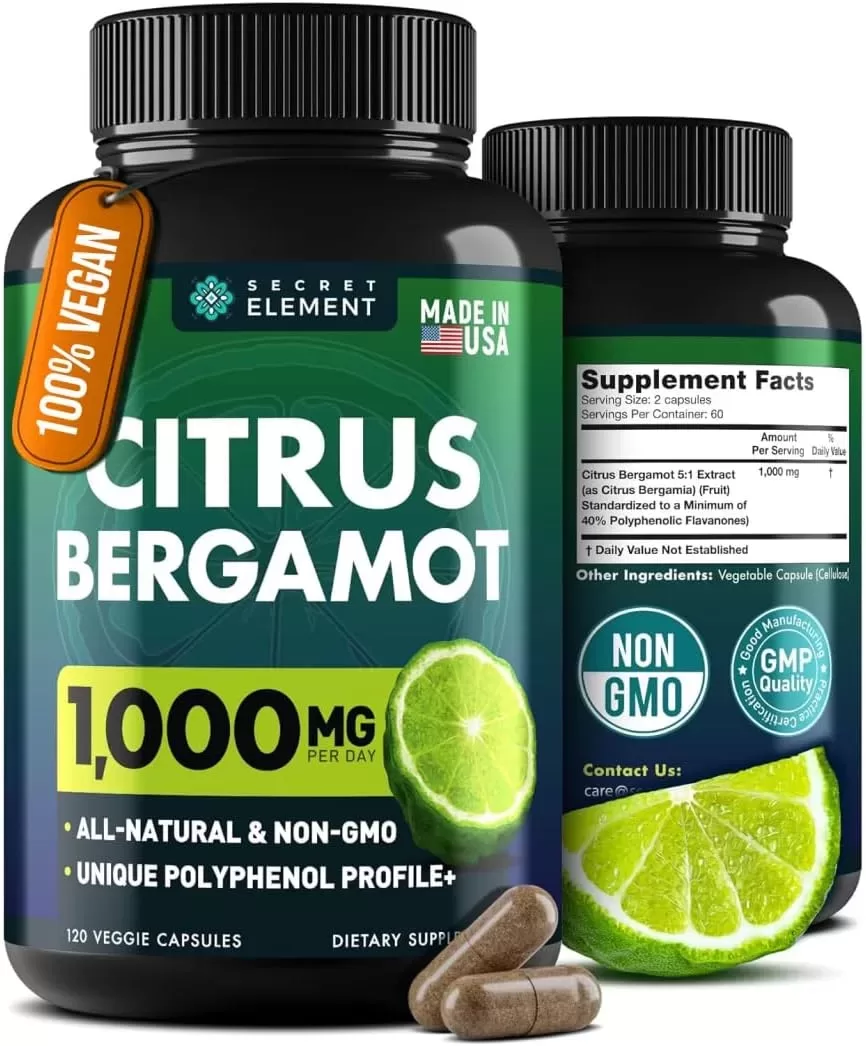Japanese cuisine goes far beyond just sushi and ramen, which are popular outside of Japan. The island offers a diverse array of dishes, all made with incredible precision. Japanese food is known for being both delicious and healthy, with a focus on fresh, flavorful ingredients. This traditional diet is highly valued in Japan and has earned global recognition for its health benefits.
In recent years, Japanese cuisine has evolved with modern trends while preserving its authentic flavors. Dishes like sushi and ramen are being reinvented with healthier, plant-based ingredients to cater to the growing demand for vegan options. Many Japanese restaurants are also embracing sustainability and using fresh, local produce, aligning with the global shift towards healthier, eco-conscious dining. This contemporary approach to traditional Japanese food makes it even more appealing to those seeking both nutritious and flavorful meals.
Table of Contents
ToggleTop 9 Must-Try Japanese Dishes

Sushi
Sushi is perhaps the most iconic of Japanese dishes, combining vinegared rice with a variety of fresh seafood, vegetables, or egg. From nigiri to maki rolls, each bite offers a perfect balance of flavors and textures. Sushi is best enjoyed fresh, often dipped in soy sauce with a hint of wasabi for extra heat.
While traditional sushi emphasizes raw fish, modern variations include vegetarian options and unique ingredients, making sushi a versatile favorite for all tastes. Whether at a high-end sushi bar or a casual restaurant, this dish is a must-try for any Japanese food lover.

Sashimi
Sashimi highlights the pure taste of raw seafood, served without rice. This delicate dish features thinly sliced fish such as tuna, salmon, or octopus, often accompanied by soy sauce, wasabi, and pickled ginger. The focus is entirely on the freshness and quality of the fish, making sashimi a refined and elegant choice.
For those who appreciate the natural flavors of the sea, sashimi is a standout. It requires skilled preparation to ensure the perfect texture and flavor in every slice, making it a true representation of Japanese culinary precision.

Tempura
Tempura is a popular Japanese dish where seafood, vegetables, or even meat are lightly battered and deep-fried to perfection. The batter is crispy and airy, making tempura a light yet satisfying option. It’s often served with dipping sauces and rice or as a topping for udon noodles.
What sets tempura apart is the careful attention to frying technique, ensuring that each piece retains its natural flavor while being encased in a golden, crispy shell. This dish is perfect for those who enjoy a crunchy texture without the heaviness of traditional deep-fried foods.

Ramen
Ramen is a beloved Japanese noodle soup that comes in various flavors and styles. Typically made with wheat noodles, the broth can range from rich and creamy pork-based tonkotsu to lighter soy or miso flavors. It’s usually topped with ingredients like sliced pork, green onions, boiled eggs, and seaweed.
Ramen has gained international popularity for its hearty, comforting appeal. Whether enjoyed in a traditional ramen shop or as a quick meal at home, the combination of flavorful broth and chewy noodles makes this dish a satisfying must-try.

Miso Soup
Miso soup is a staple in Japanese cuisine, often served as a side dish with meals. Made from fermented soybean paste (miso), the soup has a savory, umami-rich flavor. Common ingredients include tofu, seaweed, and green onions, though variations with mushrooms or vegetables also exist.
This simple yet nutritious soup is known for its health benefits, particularly for digestion. It’s a comforting dish that can be enjoyed any time of day and provides a perfect introduction to the flavors of Japanese food.

Yakitori
Yakitori consists of skewered and grilled chicken pieces, seasoned with either salt or a sweet soy-based sauce called tare. The skewers can include various cuts of chicken, from breast and thigh meat to more adventurous options like liver and skin, all grilled to smoky perfection.
Yakitori is often enjoyed as street food or at izakayas (Japanese pubs), where it’s paired with beer or sake. Its smoky, savory flavor makes it a crowd-pleaser and a fun way to experience the versatility of Japanese grilling techniques.

Okonomiyaki
Okonomiyaki is a savory pancake made with flour, eggs, cabbage, and various fillings such as pork, seafood, or vegetables. The name “okonomiyaki” roughly translates to “grill what you like,” reflecting the flexibility in ingredients. It’s cooked on a griddle and topped with sauces, mayonnaise, and bonito flakes.
This dish is particularly popular in Osaka and Hiroshima, each having its regional take on the recipe. Okonomiyaki is a hearty, flavorful dish that showcases the creativity and fun side of Japanese street food culture.

Tonkatsu
Tonkatsu is a breaded and deep-fried pork cutlet, typically served with shredded cabbage and a thick, tangy sauce. The pork is coated in panko breadcrumbs before frying, which gives it an extra crispy texture.
This dish offers a satisfying combination of crispy coating and juicy meat. Often enjoyed with rice and miso soup on the side, tonkatsu is a filling and flavorful meal that highlights the Japanese love for balance in texture and taste.

Udon & Soba
Udon and soba are two types of traditional Japanese noodles. Udon noodles are thick, chewy, and usually served in a hot broth with toppings like tempura or green onions. Soba noodles, made from buckwheat, are thinner and can be served hot or cold, making them a versatile option year-round.
Both noodles are staples in Japanese cuisine and are often enjoyed in simple, hearty dishes that focus on the natural flavors of the ingredients. Whether you prefer the soft, comforting texture of udon or the nutty flavor of soba, these noodles are a must-try for any food enthusiast.
Best Japanese Street Food

Takoyaki
Takoyaki is a popular Japanese street food made from batter filled with diced octopus, tempura scraps, green onions, and pickled ginger. It’s cooked in a special round mold, resulting in crispy balls with a soft center. Takoyaki is typically topped with savory sauces, bonito flakes, and mayonnaise, offering a rich and flavorful snack. Commonly found at festivals and street stalls, this dish is a must-try for anyone wanting a taste of Japanese street food culture.

Taiyaki
Taiyaki is a fish-shaped pastry often filled with sweet red bean paste, though modern fillings like custard or chocolate are also popular. The outer dough resembles a waffle, giving it a crispy texture. This beloved treat is a staple at Japanese festivals and markets, enjoyed for its playful shape and delicious filling, making it a favorite among both children and adults.

Dango
Dango is a traditional Japanese sweet made from rice flour, typically served on skewers. The most popular version, mitarashi dango, is coated in a sweet soy sauce glaze that offers a perfect balance of sweet and savory flavors. Dango is often enjoyed at festivals or tea ceremonies, and its chewy texture and simple ingredients make it a classic in Japanese dessert culture.
Japanese Cuisine Famous Restaurants
The best way to experience authentic Japanese cuisine worldwide is by visiting these famous restaurants, each known for their culinary expertise and unique approach to Japanese dishes:

Nobu
Nobu is globally renowned for its sophisticated sushi and Japanese-Peruvian fusion dishes. Founded by Chef Nobu Matsuhisa, this restaurant chain offers a fine dining experience that blends traditional Japanese techniques with modern, inventive flavors.

Sushi Yasuda
Sushi Yasuda is known for its commitment to the art of sushi, with a focus on simplicity and the freshest ingredients. The restaurant provides an authentic sushi experience where the flavors of the fish take center stage, with expert preparation and minimal distractions.

Ippudo
Famous for its ramen, Ippudo specializes in tonkotsu (pork-based) broth, offering rich and flavorful bowls with perfectly cooked noodles. Their expertise in ramen craftsmanship has earned them international fame, making Ippudo a must-visit for ramen enthusiasts.
What makes Japanese food healthy?
Japanese food is often seen as healthy because it focuses on fresh, seasonal ingredients and balanced nutrition. Fish, a common part of Japanese meals, is rich in omega-3 fatty acids, which are good for heart health. The cuisine also includes a variety of vegetables, tofu, and seaweed, all of which provide important vitamins, minerals, and fiber. With minimal use of oil, Japanese dishes tend to be lighter and lower in calories compared to many Western foods.
Portion control and variety also play a role in making Japanese food healthier. The traditional “Ichiju Sansai” approach—one soup and three side dishes—encourages smaller portions of different food groups, providing a good mix of proteins, carbohydrates, and healthy fats. Staples like miso soup and green tea also add antioxidants, which are great for overall well-being. Altogether, these factors make Japanese food a healthy and balanced choice.
Japanese Cuisine: Flavors & Ingredients
Japanese cuisine is renowned for its unique combination of fresh, natural ingredients and well-balanced flavors that reflect the country’s cultural and geographic influences. Here are some key elements that make Japanese cuisine stand out:
- Umami: Known as the “fifth taste,” umami gives Japanese dishes their savory depth. It’s found in ingredients like soy sauce, miso, seaweed, and dashi (broth made from kelp and bonito flakes), providing a rich, complex flavor unique to Japanese cooking.
- Soy Sauce & Miso: These fermented ingredients are essential to many Japanese dishes, offering salty and savory flavors that complement rice, vegetables, and seafood. Miso, in particular, adds a slightly sweet, earthy taste to soups and marinades.
- Fresh Seafood: As an island nation, Japan has access to some of the best seafood, including tuna, salmon, and mackerel. Seafood is often served raw as sushi or sashimi, highlighting its freshness and natural flavor.
- Rice & Noodles: Rice is a staple in Japanese meals, often served alongside various dishes, while noodles like udon and soba provide a hearty, chewy texture. Both ingredients are versatile and used in numerous traditional dishes.
- Seasonal Vegetables: Japanese cuisine emphasizes the use of fresh, seasonal vegetables like daikon, lotus root, and shiitake mushrooms, ensuring that dishes are not only flavorful but also nutrient-rich.
Popular Japanese Cookbooks

- Japanese Cooking: A Simple Art by Shizuo Tsuji
This classic cookbook simplifies the art of Japanese cooking, making traditional techniques and recipes accessible. With a focus on the basics of Japanese cuisine, it covers everything from knife skills to selecting ingredients, perfect for those wanting to master authentic Japanese dishes.

- Japanese Home Cooking: Simple Meals, Authentic Flavors by Sonoko Sakai
Sonoko Sakai’s cookbook offers simple, authentic Japanese recipes that are easy to make at home. Focusing on fresh ingredients and seasonality, it provides an approachable way to enjoy Japanese flavors in everyday meals without special tools.

- Washoku: Recipes from the Japanese Home Kitchen by Elizabeth Andoh
Washoku introduces the principles of balance in Japanese cooking, with nutritious and flavorful recipes. Elizabeth Andoh emphasizes the harmony of flavors and textures, making it a great guide for exploring authentic Japanese home-style meals.
You can easily buy this book on Amazon, making it convenient to start exploring Japanese cooking at home. With a quick purchase, you’ll have access to authentic recipes and techniques delivered right to your door.
Is the Japanese diet plant-based?
While traditional Japanese cuisine is not fully plant-based, many dishes can be adapted to suit vegan, paleo, or plant-based diets. The use of fresh vegetables, seaweed, and tofu makes it easy to enjoy Japanese food while following these dietary preferences. Here are some examples:
- Miso Soup: A vegan-friendly soup made with tofu, seaweed, and green onions in a flavorful broth of fermented soybeans.
- Edamame: Steamed or boiled soybeans that are both vegan and paleo-friendly, offering a great source of plant-based protein.
- Zaru Soba (Cold Buckwheat Noodles): Gluten-free and plant-based, these buckwheat noodles are light, healthy, and delicious.
- Seaweed Salad: A nutrient-rich plant-based dish full of minerals and perfect for a light, healthy meal.
- Vegetable Tempura: Can be adapted for vegan or paleo diets using alternative flours and plant-based oils to fry vegetables like sweet potatoes or mushrooms.
- Tofu Stir-Fry: Tofu is widely used in Japanese cuisine and makes for a versatile protein option in vegan or plant-based dishes.
Frequently Asked Questions (FAQ)
- What is the main cuisine in Japan?
- Japanese cuisine mainly includes rice, fish, seafood, and vegetables, using fresh and seasonal ingredients.
- What are the top 10 Japanese dishes?
- Sushi, sashimi, ramen, tempura, miso soup, yakitori, tonkatsu, udon, soba, and okonomiyaki.
- How do you describe Japanese cuisine?
- Japanese cuisine is simple, fresh, balanced, and rich in umami flavors.
- What makes Japanese food healthy?
- It’s healthy because it uses fresh ingredients, has low oil, and focuses on fish, rice, and vegetables for balanced nutrition.
- Is Japanese food suitable for a gluten-free diet?
- Yes, but avoid soy sauce, tempura, and wheat noodles. Choose dishes like sashimi, grilled fish, and rice-based meals.
- What are the best Japanese dishes for beginners?
- Sushi, ramen, tempura, and teriyaki chicken are good choices for beginners.
- What are the most popular Japanese street foods?
- Popular street foods include takoyaki, yakitori, taiyaki, dango, and okonomiyaki.
- How do I findauthentic Japanese restaurants near me?
- Check reviews on Google, Yelp, or TripAdvisor and look for menus with traditional dishes.
- What are some easy Japanese recipes to try at home?
- Miso soup, teriyaki chicken, sushi rolls, and tempura are easy to make at home.
- How is Japanese cuisine influenced by Chinese and Korean traditions?
- Japanese cuisine uses Chinese noodles (like ramen) and Korean fermentation methods for pickles and sauces.
Final Thoughts: The Best of Japanese Cuisine
Japanese cuisine offers an incredible variety of dishes, from sushi and tempura to miso soup and ramen, each crafted with unique flavors and textures. Whether you’re dining at Japanese restaurants or cooking at home, the richness of these dishes showcases the precision and tradition of Japanese cooking. I hope you enjoyed this article, Top Japanese Cuisine | Best Must-Try Dishes from Japan, and feel inspired to explore these iconic flavors for yourself!














Comments are closed.